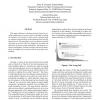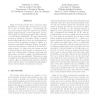SASO
2008
IEEE
14 years 7 months ago
2008
IEEE
Resource management for ad hoc grids is challenging due to the participation of heterogeneous, dynamic, autonomous and ephemeral nodes. Different underlying network infrastructure...
SASO
2008
IEEE
14 years 7 months ago
2008
IEEE
An ad hoc grid is a spontaneous formation of cooperating heterogenous computing nodes which attempts to provide computing resources on demand to every participant. In this paper, ...
SASO
2008
IEEE
14 years 7 months ago
2008
IEEE
As software is more and more interweaving with our everyday life, designing software in a way that it reflects and respects the user and her emotional physical conditions, cogniti...
SASO
2008
IEEE
14 years 7 months ago
2008
IEEE
Abstract—We present a distributed connectivity service that allows agents in a mobile ad-hoc network to move while preserving connectivity. This allows unmodified motion plannin...
SASO
2008
IEEE
14 years 7 months ago
2008
IEEE
In this paper, we describe an application-level emulator for P2P systems with a special focus on high reproducibility. We achieve reproduciblity by taking control over the schedul...
SASO
2008
IEEE
14 years 7 months ago
2008
IEEE
As technology progresses, we are seeing increasing numbers of small devices that have the capability to store, process and forward information in our everyday physical environment...
SASO
2008
IEEE
14 years 7 months ago
2008
IEEE
We consider the problem of Object Safety: how objects endowed with processing, communication, and sensing capabilities can determine their safety. We assign an agent to each objec...
SASO
2008
IEEE
14 years 7 months ago
2008
IEEE
This paper addresses a business scenario based on socalled tradable micro-services which is intended to explain the dynamics of a market to which actors contribute both as consume...
SASO
2008
IEEE
14 years 7 months ago
2008
IEEE
Abstract— On the one hand, natural phenomena of spontaneous pattern formation are generally random and repetitive, whereas, on the other hand, complicated heterogeneous architect...
SASO
2008
IEEE
14 years 7 months ago
2008
IEEE
Many real–world networks show a scale–free degree distribution, a structure that is known to be very stable in case of random failures. Unfortunately, the very same structure ...



